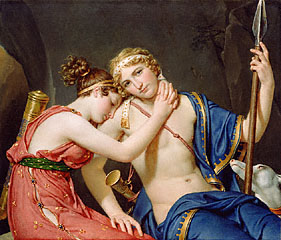• What do the body positions of the figures tell us about what is happening in the scene?
(The female figure is resting her head on the shoulder of the male figure as her arms wrap around
his shoulders and her hands grasp tight. This signifies sadness and an unwillingness to let go.
One of the male's hands is resting on the thigh of the female, while the other holds his spear.
Yet his head is leaning back toward her head. This signifies his ambivalence about leaving.)
• Contrast the expressions of
Telemachus and
Eucharis. How do they differ in this image?
(Telemachus looks out at the viewer, while Eucharis faces Telemachus with her eyes turned downward.
He seems more at ease and aware of the situation, while she seems melancholy and a bit hopeless.)
• Describe what the dog is doing in this picture. Why do you think David chose to include it in this scene?
What might a dog symbolize? (The dog is looking up at Telemachus with its head cocked back over its shoulder.
The dog may symbolize loyalty, and David may have included it to underline the importance of loyalty and devotion to a higher duty.)
• How did David show that this story takes place in
antiquity? (The clothing and accessories are in the style of antiquity.
The setting is in a
grotto rather than a contemporary interior.)
• How would you change the image to make it relevant to today? (Dress the figures in modern clothing.
Place the figures in a modern setting. Relate the story to contemporary issues such as current
military involvement, young love, etc.)
• David and other Neoclassical artists used their artwork to illustrate the morals and lessons they believed
were important in society. What do you think the lesson or moral of this painting is? (To be responsible, to be loyal
to your family or nation, and not to get sidetracked when pursuing an important goal.) |
Fixing the viewer with a gaze both challenging and seductive, the fair-haired Telemachus grasps Eucharis's thigh with his right
hand while holding his spear upright with the left. Telemachus, the son of
Odysseus, appears in
Homer's
classical text The Odyssey. In the French novel Les Aventures de Télémaque of 1699, which was loosely
based on characters from The Odyssey, the French author François Fénelon describes how Telemachus, who was shipwrecked
on Calypso's island, fell passionately in love with the beautiful nymph Eucharis. His guardian, Mentor, forced him to leave and
continue the search for his missing father.
In a scene fabricated by the artist, the ill-fated lovers say farewell in a grotto on the island. Telemachus faces us, his blue
tunic falling open to reveal his naked torso. Eucharis, seen in profile, rests her head lugubriously upon his shoulder, her fingers
red from the tight grip of her hands clasped around his neck. In this re-imagining of the story, Jacques-Louis David contrasts
masculine rectitude with female emotion.
David painted The Farewell of Telemachus and Eucharis late in life, during his exile in Brussels. The use of saturated
reds and blues in this work, characteristic of the artist's late
history paintings, may reflect the influence of the Flemish (from Flanders, in Northern Europe) paintings that surrounded him in that city (What is Flemish art?). The clarity of line and form typifies the Neoclassical style, as does the
lack of overt expression in the figures, while the patriotic (Telemachus searches for his father, the rightful ruler of Ithaca)
and high moral undertones of this painting recall the political and philosophical ideals of the Enlightenment.
About the Artist
Jacques-Louis David, 1748–1825
French
Jacques-Louis David was born in France in 1748. As a young boy he studied drawing and the literary classics and would have been
very familiar with both Homer's and Fénelon's stories. By the age of 18 he was accepted as a student by the
Académie Royale. After eight years of struggle he finally won the coveted
Prix de Rome. Visits to ruins, exposure to Neoclassical doctrines, and study of the classicism of Nicolas Poussin
(1594–1665) encouraged him to adopt a style and subject matter derived from antiquity.
Returning to Paris in 1780, David soon prospered. Large canvases of classical themes earned him election to the Académie
Royale as a member in 1784 and sensational success at the Paris
Salon in 1785. His firm, linear contours; even lighting;
pure colors; and
frieze-like composition were admired, but more than his style was revolutionary. His paintings came to be regarded
as a political manifesto for ending the corruption of an effete aristocracy and returning to the stern, patriotic morals attributed
to
Republican Rome.
Known as "the
Robespierre of the brush," David served in the French Revolutionary government. He painted portraits of its leaders,
designed its republican festivals and funerals, and suffered imprisonment when the political winds shifted. Despite his impassioned
earlier rhetoric—"The artist must be a philosopher and should have no other guide except the torch of reason"—David
placed his faith first in Robespierre and then, after becoming disenchanted with that "guide," in Napoleon, the new ruler of
France. After Napoleon's fall from power, David was exiled to Brussels due to his antiroyalist beliefs, where he continued to
train young painters and draftsmen.
|

